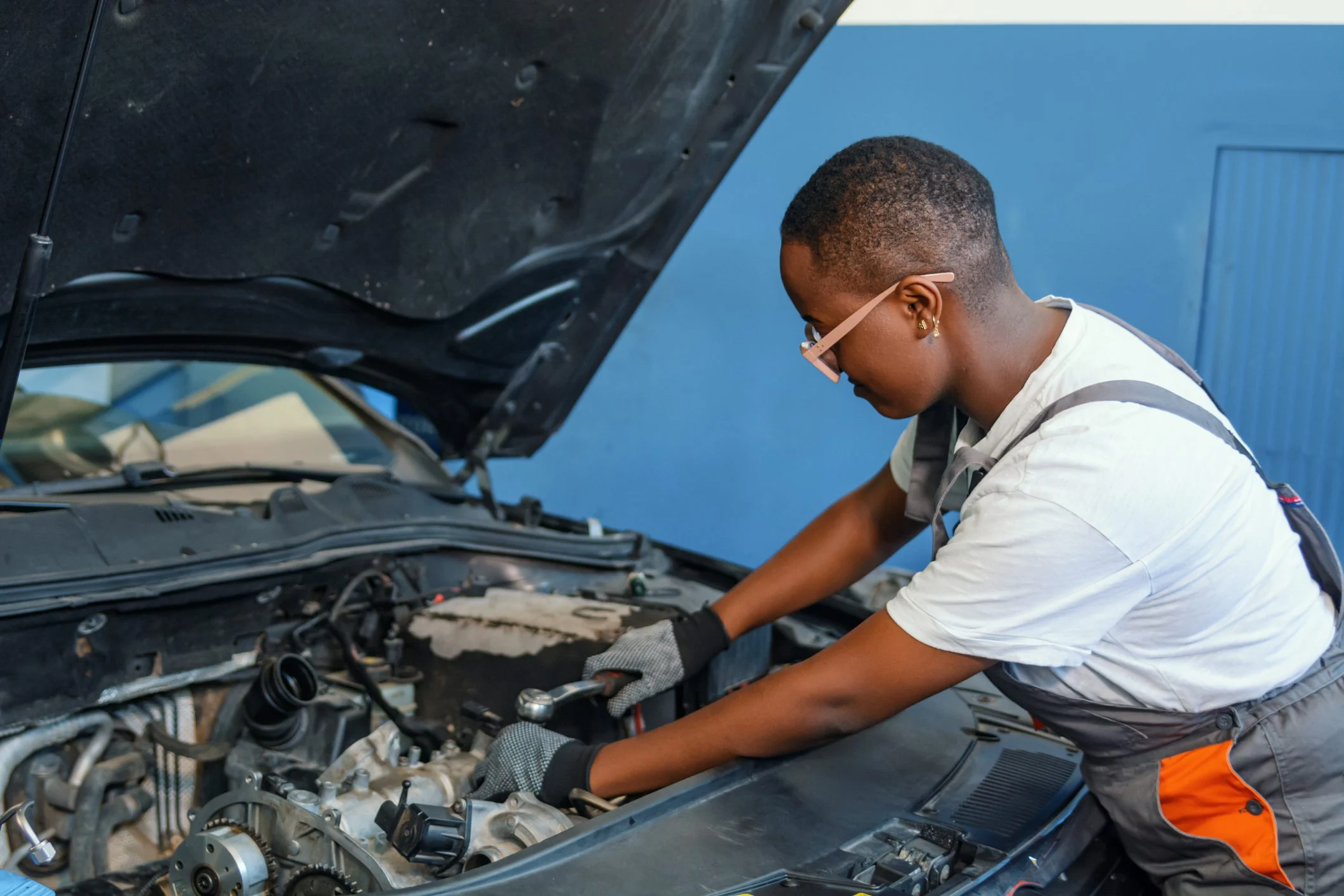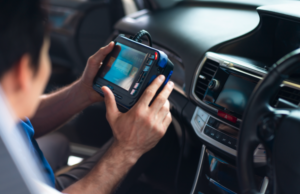DIY car maintenance saves money and builds skills, but safety is critical to avoid injuries or damage. This guide is for car owners with beginner to intermediate skills, offering 10 essential safety tips for working at home. With clear instructions, practical advice, and real-world examples, you’ll learn how to perform tasks like oil changes or tire rotations confidently while staying safe. Whether you’re new to DIY or refining your approach, these tips ensure a secure and productive workspace.
Why Safety Matters in DIY Car Maintenance
Car maintenance involves heavy vehicles, sharp tools, and hazardous fluids. Mistakes lead to serious consequences: falls cause 20% of home injuries, per the National Safety Council, costing $50–$5,000 in medical bills. Fluid spills pollute, risking $100–$1,000 fines, per the Environmental Protection Agency (EPA). Vehicle collapses from improper lifting kill dozens yearly, per OSHA, and damage parts ($500–$5,000). Safe practices prevent these risks, saving $50–$500 per job versus shops, per automotive estimates, while ensuring your car—whether a 2020 Toyota Corolla or 2018 Ford F-150—stays reliable.
Implementing safety takes minimal cost ($20–$100 for gear) and adds 5–10 minutes per task, empowering DIYers to work confidently. Easier than repairs but requiring discipline, it’s foundational for all skill levels. By prioritizing safety, you’ll protect yourself, your car, and your wallet.
Tools and Materials Needed
These items enhance safety across maintenance tasks:
- Personal Protective Equipment (PPE):
- Safety glasses ($5–$10, for debris)
- Gloves (nitrile or mechanic’s, $5–$10, for fluids)
- Steel-toe or sturdy shoes ($20–$50, for dropped tools)
- Lifting and Support:
- Wheel chocks ($10–$20, to prevent rolling)
- Jack stands (2–3-ton, $20–$50)
- Floor jack (2–3-ton, $30–$100)
- Workspace Safety:
- Work light (LED, 500–1000 lumens, $10–$50)
- Fire extinguisher (ABC type, $20–$50, for fluids)
- Spill kit ($10–$30, for oil/coolant)
- First-aid kit ($10–$30, for cuts)
- Fluid Handling:
- Catch pan ($5–$20, for spills)
- Funnel ($3–$10, for pouring)
- Rags ($3–$5, for cleanup)
- Optional:
- Shop fan ($10–$50, for ventilation)
- Floor mats ($20–$100, for grip)
- Warning cones ($5–$20, for kids/pets)
- Notebook ($2–$5, to log safety checks)
Choose quality brands (e.g., Torin for stands, Kidde for extinguishers) for reliability. Check your car’s manual for weight (e.g., 3,000 lbs for a 2021 Honda Civic) to match jack/stand ratings. Most tasks—like fluid checks or battery tests—benefit from these safety items.
Tip 1: Work on a Stable, Level Surface
Why It Matters: Uneven ground causes jacks to tip, risking vehicle collapse ($500–$5,000 damage, $100–$10,000 injury).
- How to Do It:
- Choose a flat garage or driveway—avoid grass or gravel.
- Test levelness: roll a ball; it shouldn’t move fast.
- Park with the brake engaged and wheels straight.
- Place wheel chocks ($10–$20) on opposite tires (e.g., rear if lifting front).
- For a 2019 Subaru Outback, ensure 3,500-pound jack/stands match.
- Example: Before a tire rotation, Tom parks his 2022 Nissan Altima on his concrete garage floor, sets chocks, and confirms no slope.
- Cost: $10–$20 (chocks).
- Savings: $500–$5,000 (no collapse).
Pro Tip: Sweep debris—grit destabilizes jacks ($5–$50 damage).
Tip 2: Use Proper Lifting Equipment
Why It Matters: Jacks alone fail under load—stands prevent crushing injuries (1,000 deaths yearly, per OSHA).
- How to Do It:
- Use a floor jack rated for your car (e.g., 2-ton for a 2020 Chevy Equinox).
- Lift at frame points (check manual, e.g., pinch welds).
- Place jack stands under axles or frame, lower car onto them.
- Shake gently to confirm stability—never work under a jack alone.
- Store stands low—falling hurts ($20–$100).
- Example: Sarah lifts her 2021 Jeep Cherokee for an oil change, sets 3-ton stands, and verifies no wobble.
- Cost: $50–$150 (jack, stands).
- Savings: $500–$10,000 (injury, damage).
Pro Tip: Double-check stand pins—loose ones slip ($50–$500).
Tip 3: Wear Protective Gear
Why It Matters: Debris, fluids, or tools cause 30% of DIY injuries, per the Consumer Product Safety Commission ($50–$1,000 medical).
- How to Do It:
- Wear safety glasses ($5–$10) for grinding, fluid work (e.g., coolant splash).
- Use gloves for oil, battery acid—nitrile resists chemicals ($5–$10).
- Choose sturdy shoes—sneakers don’t stop wrenches ($20–$50).
- Avoid loose clothing—catches in belts ($100–$1,000 injury).
- Keep gear near workbench for quick access.
- Example: Mike wears glasses and gloves while testing his 2018 Dodge Ram’s battery, avoiding acid burns.
- Cost: $20–$70.
- Savings: $50–$1,000 (medical).
Pro Tip: Replace cracked glasses—faulty ones fail ($5–$10).
Tip 4: Turn Off the Engine and Disconnect Power
Why It Matters: Running engines or live batteries spark or move parts, risking shocks or cuts ($50–$5,000).
- How to Do It:
- Turn off engine, remove key before work (except diagnostics).
- Disconnect battery negative (-) for electrical tasks (e.g., fuse replacement).
- Wait 5 minutes after shutdown—fans spin ($50–$500 injury).
- For a 2020 Hyundai Tucson, use a 10mm wrench to loosen cables.
- Reconnect only when tools are clear.
- Example: Lisa unplugs her 2022 Kia Sorento’s battery before swapping bulbs, preventing shocks.
- Cost: $0–$10 (wrench).
- Savings: $50–$5,000 (injury, fire).
Pro Tip: Mark cables with tape—wrong connections spark ($5–$50).
Tip 5: Handle Fluids with Care
Why It Matters: Spilled oil, coolant, or brake fluid pollutes (one quart taints thousands of gallons, per EPA) or slips ($100–$1,000).
- How to Do It:
- Use a catch pan ($5–$20) under drain plugs (e.g., oil change).
- Pour with a funnel ($3–$10) to avoid spills.
- Store fluids upright, away from heat—leaks ignite ($500–$5,000).
- Clean spills with a spill kit ($10–$30) or sawdust.
- Recycle at AutoZone—free, avoids $100–$500 fines.
- Example: John uses a pan for his 2019 Toyota RAV4’s coolant swap, recycling old fluid safely.
- Cost: $20–$60.
- Savings: $100–$5,000 (fines, fires).
Pro Tip: Check fluid types—mixing damages ($200–$1,000).
Tip 6: Ensure Proper Lighting
Why It Matters: Dim light causes errors—stripped bolts or missed leaks cost $5–$500, per repair estimates.
- How to Do It:
- Use an LED work light (500–1000 lumens, $10–$50) above or under car.
- Position magnetic lights on hood for engine work (e.g., battery check).
- Test daytime—garages dim fast ($5–$50 errors).
- Keep cords away from fluids—shorts spark ($50–$500).
- For a 2021 Subaru Forester, light the engine bay fully.
- Example: Emma clips a light to her 2020 VW Tiguan’s hood, spotting a loose clamp.
- Cost: $10–$50.
- Savings: $5–$500 (errors).
Pro Tip: Charge lights before jobs—dead ones delay ($10–$50).
Tip 7: Ventilate Your Workspace
Why It Matters: Fluid or exhaust fumes cause dizziness or poisoning, affecting 10% of DIYers yearly ($50–$1,000 medical).
- How to Do It:
- Open garage door fully during work—circulates air.
- Use a fan ($10–$50) to push fumes out, not in.
- Avoid running engines indoors—carbon monoxide kills ($500–$5,000).
- Wear a mask if spraying cleaners ($5–$10).
- For a 2022 Mazda CX-5, ventilate before fluid checks.
- Example: Carlos opens his garage and adds a fan while changing his 2018 Chevy Silverado’s oil.
- Cost: $10–$60.
- Savings: $50–$5,000 (medical).
Pro Tip: Check weather—rain wets tools ($5–$50 rust).
Tip 8: Keep a Fire Extinguisher Handy
Why It Matters: Fluid or electrical fires spread fast—garages burn in minutes, costing $500–$10,000, per NFPA.
- How to Do It:
- Get an ABC extinguisher ($20–$50, for fluids, electrical).
- Mount near exit, not workbench—access matters.
- Check pressure yearly—low ones fail ($5–$20).
- Learn PASS: Pull pin, Aim, Squeeze, Sweep.
- Place away from fluids—sparks ignite ($100–$5,000).
- Example: Tina keeps an extinguisher by her 2019 Jeep Cherokee’s garage door, ready for emergencies.
- Cost: $20–$50.
- Savings: $500–$10,000 (fire).
Pro Tip: Practice with a trainer unit—panic wastes time ($20–$50).
Tip 9: Organize Tools and Work Area
Why It Matters: Clutter causes trips or lost tools, delaying jobs ($5–$50) or injuring ($50–$1,000).
- How to Do It:
- Store tools in a toolbox ($20–$200)—label drawers (e.g., “sockets”).
- Clear floor before work—rags or cords trip ($50–$500).
- Use bins for parts ($5–$20)—no loose bolts.
- Return tools after use—searching wastes time ($5–$50).
- For a 2020 Ford Escape, keep wrenches near jack.
- Example: Dave organizes his 2021 Ram 1500’s tools in a chest, avoiding spills during a brake check.
- Cost: $30–$240.
- Savings: $50–$1,000 (injury, time).
Pro Tip: Use a magnet to catch dropped screws—saves 5–10 minutes ($5–$20).
Tip 10: Know When to Stop and Get Help
Why It Matters: Overconfidence leads to errors—complex jobs like timing belts cost $500–$5,000 if botched.
- How to Do It:
- Assess skills: beginners stick to fluids, tires; intermediates try brakes.
- Stop if stuck—stripped bolts or leaks worsen ($50–$500).
- Watch videos (e.g., “oil change DIY”) before starting.
- Call a mechanic for:
- Electrical shorts ($200–$1,000)
- Transmission faults ($1,000–$5,000)
- Structural damage ($500–$3,000)
- Keep a shop number handy (e.g., local Pep Boys).
- Example: Sam pauses his 2022 Tesla Model 3’s wiring job, calling a pro to avoid ECU damage.
- Cost: $0–$50 (research).
- Savings: $500–$5,000 (errors).
Pro Tip: Log tasks (e.g., “Oil, safe, Dec 2025”) to track limits—builds confidence ($50–$500).
Maintaining Safety Over Time
Keep safety first:
- Inspect Gear:
- Check stands for cracks yearly—replace if bent ($20–$50).
- Test extinguisher pressure ($5–$20).
- Replace worn gloves/glasses ($5–$20).
- Practice Routines:
- Run a safety checklist before jobs: chocks, gear, light.
- Spend 5 minutes planning—saves $50–$500.
- Stay Educated:
- Read manuals for new tasks (e.g., battery swap).
- Join forums (e.g., Reddit r/MechanicAdvice, $0–$20).
- Clean Workspace:
- Sweep after jobs—grit slips ($5–$50).
- Recycle fluids—free at O’Reilly ($100–$500 fines).
Pro Tip: Review one tip monthly—habits stick, saving $50–$1,000 yearly.
Common Mistakes to Avoid
- Skipping Stands: Jacks fail ($500–$5,000).
- No Gear: Fluid burns or cuts ($50–$1,000).
- Poor Light: Errors strip parts ($5–$500).
- Running Engine: Fans or belts injure ($50–$5,000).
- Cluttered Floor: Trips cost ($50–$1,000).
- Ignoring Limits: Botched jobs escalate ($500–$5,000).
When to Seek Professional Help
Safety tips cover most tasks, but see a mechanic for:
- Complex Repairs: Timing belts, ECU ($500–$5,000).
- Electrical Fires: Shorts or sparks ($200–$1,000).
- Structural Issues: Frame rust ($500–$3,000).
- Persistent Faults: Codes or noises ($200–$2,000).
- No Confidence: Risky tasks need pros ($50–$500).
Shops charge $50–$500 per job, but DIY with safety saves money.
Additional Tips for Safe DIY
- Start Small: Try fluid checks before brakes ($50–$200 savings).
- Work in Pairs: Helpers spot risks ($50–$1,000).
- Check Weather: Wet floors slip ($50–$500).
- Keep Kids/Pets Away: Cones warn ($5–$20).
- Log Incidents: Near-misses teach ($0–$50).
- Restock First-Aid: Bandages expire ($10–$30).
Conclusion
DIY car maintenance safety, with these 10 must-know tips, protects you and your vehicle while saving money. From stable surfaces to fire extinguishers, each step ensures secure work at home. This guide suits beginners to intermediates, while tips like logging tasks or cleaning help all DIYers.
Next, try safe tasks like tire pressure checks or wiper swaps (see related guides). If risks arise, consult a mechanic. With $20–$100 in gear and a safety mindset, you’re set for worry-free maintenance!




